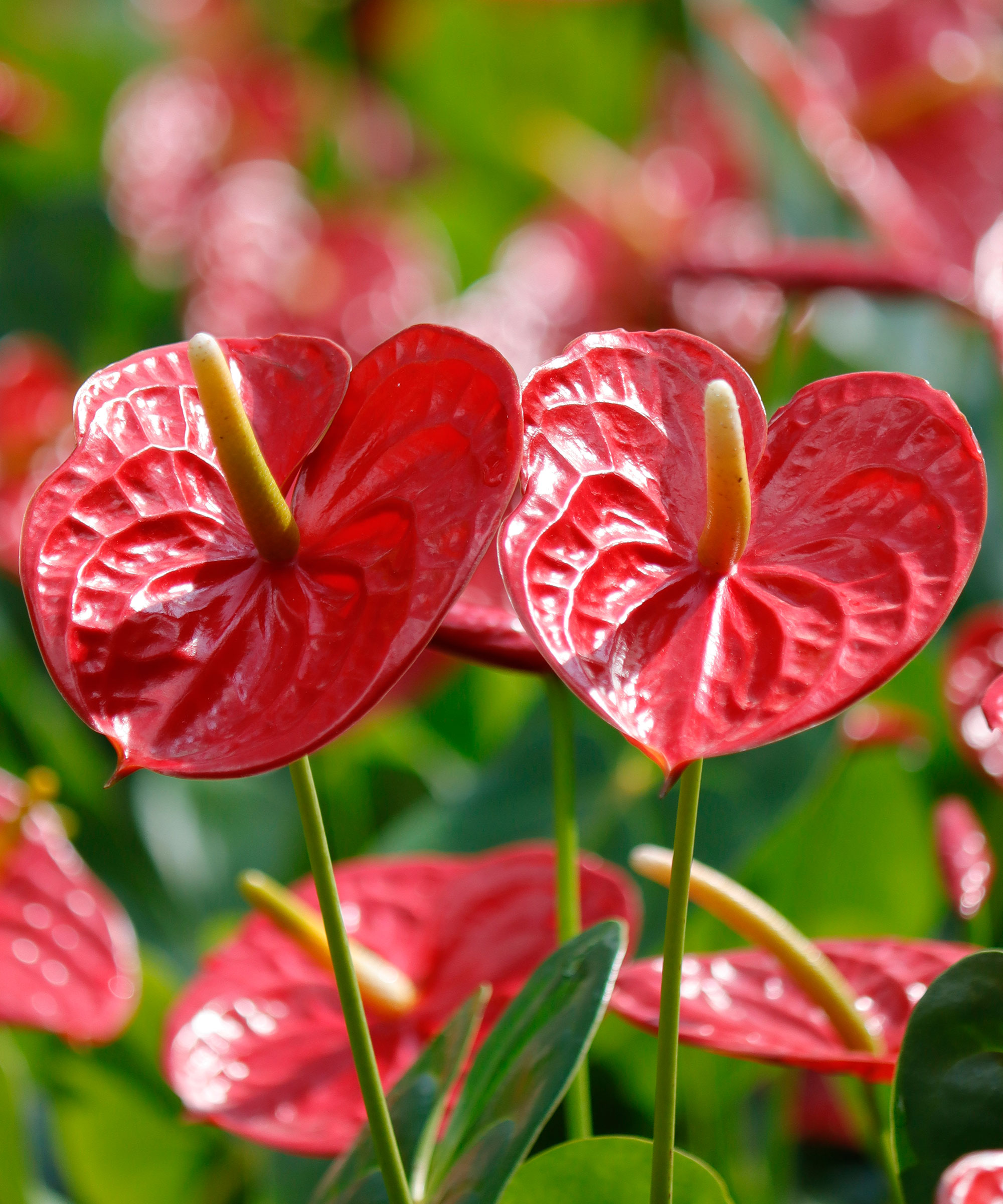Anthurium care and growing guide – expert tips for these tropical indoor plants
Our expert anthurium care tips will keep these popular flowering houseplants blooming for months at a time


If you’re looking for a colorful indoor plant to brighten up your home all year round, an elegant anthurium offers the perfect choice. Native to central America, northern Argentina and parts of the Caribbean, the most popular species is Anthurium andraeanum, commonly known as the flamingo flower, painter’s palette or tail flower.
Its large, eye-catching blooms come in a range of colors, including red, pink, white, and burgundy, and they comprise an outer waxy, heart-shaped spathe (leaf-like sheath) and a long spike of tiny flowers, known as the spadix. These striking indoor plants flower for long periods throughout the year and when they’re briefly not in bloom, the glossy spear-shaped foliage helps to keep the show going.
Houseplant connoisseurs may also like to try some of the other species. Adam Besheer, co-owner of New York-based online houseplant shop and retail store Greenery Unlimited recommends the bird’s nest anthurium, Anthurium hookeri, which gets its name from the roots which wrap around each other to form a nest. 'I personally love the unique structural shape of this anthurium’s leaves too. Another favourite of mine is Anthurium crystallinum which has beautiful leaf patterning and is relatively easy to care for,' he says.

Anthuriums bloom for long periods of time

Zia Allaway is a highly experienced garden book author, editor, and journalist, covering a wide range of gardening topics in her work. She has also written a number of books, including several on houseplants such as The RHS Practical House Plant Book and Practical Cactus & Succulent Book, both available on Amazon.
Where to place anthurium plants
Adam Besheer recommends placing your anthurium in a bright position out of direct sunlight. 'The leaves will often bleach when placed in a window, but that doesn't mean these plants don't like light,' he says. 'A good indicator that your plant is suffering from a lack of light is if it tips over while stretching towards the sun.'
Anthuriums also require a humid atmosphere and therefore make good kitchen plants or bathroom plants.
In their natural habitat these tropical indoor plants are rarely subjected to cold temperatures, so bear this in mind and keep yours in a warm area, away from drafts.
- Shop anthurium plants at The Amazon
- Shop anthurium plants at The Sill
- Shop anthurium plants at Plants.com
How to water and feed anthuriums
How often to water indoor plants can vary depending on the plant type and your home environment, but there is a general guide to follow. 'Anthuriums should be watered when about 50 per cent of their soil is dry,' advises Lindsay Pangborn, plant expert at online retailer Bloomscape. In practical terms, this means when the top of the compost feels dry but when you slip the plant out of its pot, there is still some moisture at the bottom of the rootball.
Design expertise in your inbox – from inspiring decorating ideas and beautiful celebrity homes to practical gardening advice and shopping round-ups.
'When watering, add it slowly, allowing the soil to absorb the moisture, until it flows freely through the drainage hole,' she adds. 'Remove any excess water that collects in the saucer or waterproof container to prevent root rot, which may eventually lead to the plant’s death.'
Watering your plant over the kitchen sink and leaving it to drain fully before putting it back in place is another easy way to prevent these indoor flowering plants from rotting.
Anthuriums also enjoy humid environments. To increase the humidity around your plant, place it on a tray of pebbles topped up with water, group it with other plants, or use a plant humidifier, available from Amazon. In warmer weather, simply opening the windows can increase the humidity levels too.
Lindsay warns that while these plants like a little fertilizer, applying too much can be detrimental. 'Anthuriums are sensitive to excess salt build-up in the soil, which can occur if you fertilize anthurium too frequently. Feeding once every two to three months from spring to early fall with a balanced fertilizer, such as a 20-20-20 or 10-10-10, is sufficient, and always apply it to damp soil at the strength recommended on the label.' This Bonide Houseplant Liquid Plant Food from Amazon is a 10-10-10 mix, meaning it contains equal amounts of nitrogen, phosphorus, and potassium.

Allow the water to fully drain out of the pot when watering an anthurium plant
Key problems with anthuriums and how to solve them
Take care not to overwater your anthurium, which may cause the roots to rot and the plant to wilt and eventually die. Underwatering is less harmful, so if the leaves and stems are wilting and the soil feels dry, watering should quickly fix the problem.
Placing your plant in strong sunlight may cause the leaves to discolor and turn yellow, which can also be a reason for monstera leaves turning yellow too. If you see this symptom, move the plant away from the window, but also check that the soil is not too wet, which can have a similar effect. Take care to provide plenty of light if you want your anthurium to bloom again.
Adam Besheer says: 'Over-fertilization can also be a problem, and plants will quickly let you know if you've gone too far by developing yellow spotting on their leaves. As for pests, anthuriums are particularly susceptible to spider mites, and scale insects and mealy bugs can also be a problem.' Spider mites can also be a problem for many other houseplants such as the string-of-hearts and fiddle leaf figs.
Red spider mite causes mottled foliage, while scale insects look like little bumps on the stems and leaves. Mealy bugs are woodlice-like creatures that hide beneath a fluffy white coating.
If you catch these pests at an early stage and they are only on a few stems or leaves, the simplest solution is to remove the affected parts. Or you may be able to wipe off scale and mealy bugs. A biological control may be effective in treating a heavier infestation of spider mite and scale insects, or try an organic spray based on natural pyrethrum or plant oils – the latter can also help to control mealy bugs. A product such as Mighty Mint Plant Protection from Amazon is easy to apply and can be used to kill spider mites, insects and fungal diseases on your houseplants.

Strong sunlight can cause yellowing leaves
Do anthuriums like shade or sun?
Lindsay Pangborn, plant expert at Bloomscape says these plants actually need a bit of both, so aren't a top choice as a low light indoor plant: 'Anthuriums thrive in settings that offer bright, indirect light. They can tolerate some direct sun in the morning, but the harsh rays of the afternoon sun should be avoided.'
A sunny windowsill will, therefore, be too bright for them, so place your plants further inside the room for the best results.
Are anthuriums a high-maintenance houseplant?
While anthuriums are a little fussy about their growing conditions, when you give them what they need, they are very rewarding and easy indoor plants.
'Anthurium andraeanum is my favorite because it’s the easiest to care for, resilient to a missed watering, and adds color to my houseplant collection,' says Lindsay Pangborn, plant expert at Bloomscape.
The popular crystal anthurium will also thrive without much maintenance.
Can you grow anthurium houseplants outdoors?
You can place your anthurium houseplant outside in summer when temperatures are above 61˚F, day and night, but Adam Besheer, co-owner of New York-based online houseplant shop and retail store Greenery Unlimited recommends keeping them in shade to avoid leaf scorch.
Lindsay Pangborn from Bloomscape suggests keeping them in a pot with drainage holes in the base. 'Or plant them in the ground in well-draining garden soil, but keep an eye on temperatures and bring them in again before the frosts hit in fall.'

Zia Allaway is a garden book author, editor, and journalist, and writes for a range of gardening and women’s magazines, including Easy Gardens, Homes & Gardens and Livingetc, as well as The Guardian and The Daily Telegraph newspapers. She has also written books for the Royal Horticultural Society and Dorling Kindersley publishers, including Eco-Gardening, Compost, Low Maintenance, Practical House Plant Book, Practical Cactus & Succulent Book, Indoor Edible Garden, What Plant Where, and the Encyclopedia of Plants and Flowers.